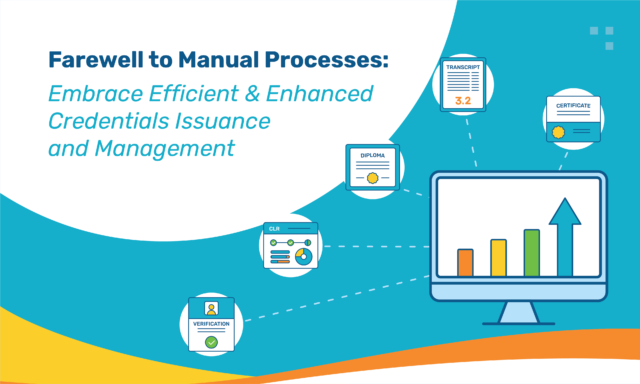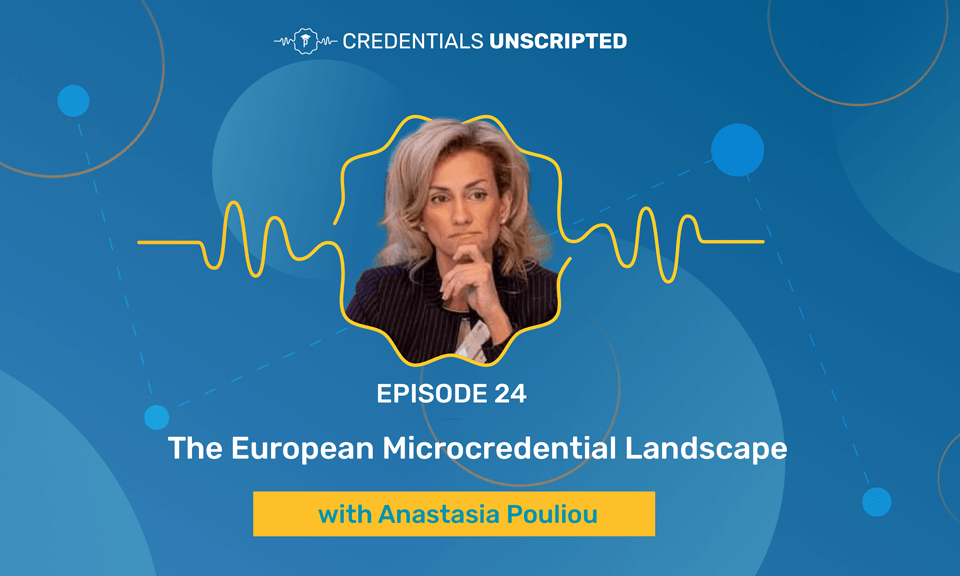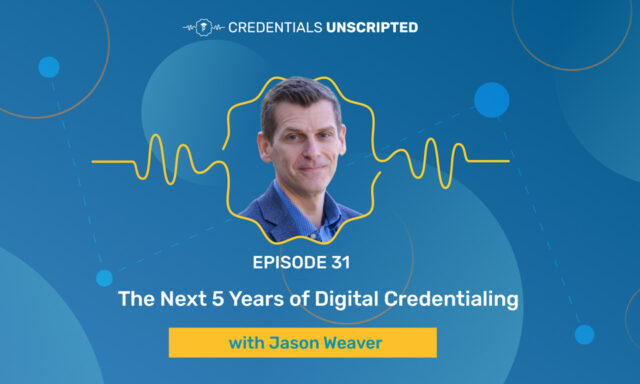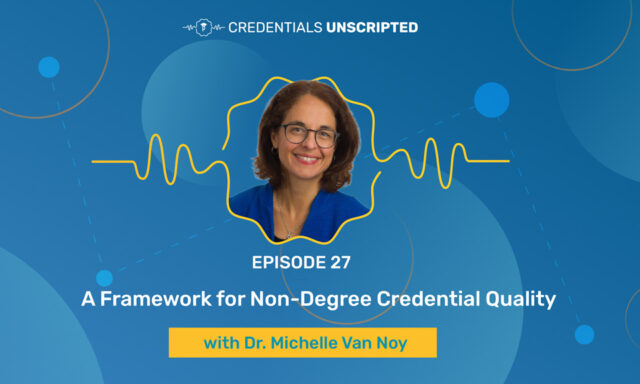What is the microcredentialing landscape in Europe? In this episode, we are joined by Anastasia Pouliou, an expert in Vocational Education & Training from Cedefop. She shares the work being done in Europe on microcredentials, how they are aligning to qualifications frameworks, and how microcredentials can impact learning.
Transcript
Matthew Sterenberg (00:15.874)
Welcome to the podcast. I’m really excited about this conversation. Your work is with Cedefop. Tell us a little bit more about the work of Cedefop and the work that you’re doing with microcredentials.
Anastasia Pouliou (00:28.149)
Thank you, Matthew, and thank you for this kind invitation to be in your panel. honoured. Well said, it was actually the European Centre for the Development of Vocational Training in Europe. We try to do a lot of work and we try to collect evidence and do a lot of research on issues related to qualifications, skills, labor market analysis.
really our mandate is really touching upon different parts of vocational education and training as a system, but not only. And we have a very good cooperation with member states and of course there is a two-part type, let’s say, management board for Cedefop, but there are people, let’s say, representing member states, trade unions, social partners, European Commission.
But in essence, what we try to do is we try to talk to the public, to the European citizens, and we try to give them advice, let’s say, and to show them what, for example, would be a good practice in Europe and could perhaps be an inspiration also for countries outside of it. So what I’m doing, well, I’m an expert in qualifications and credentials and the important area on the future of VETS, of Vocational Education and Training, and I’m leading currently the research on micro-credentials.
for VET and labor market learning. And this is a very concrete focus we had back in 2019 when we started because we felt, yeah, lots of discussion and articles and research reports were written mainly with regards to higher education, academic education, but what is really happening in VET and concretely in the labor market side? Well, that was missing. So this is why we have our minds on that.
Matthew Sterenberg (02:10.39)
Well, that’s a lot and it’s a lot of really good stuff. You wrote a working paper, exploring the emergence of micro credentials in vocational education and training. if for those of you listening to this, make sure you check that out because I think it provides a really good context for what’s going on. And really the conversation today is not that you can speak for everything happening in Europe, I micro credentials is this emerging thing in the U S.
and really wanted the perspective of what’s going on in Europe, what’s happening there. And so one of the quotes from your paper, which I really wanted to highlight because it resonated with me, I think what’s happening in the US, which is, despite their rising popularity, the environment in which micro-credentials are developed is blurry. What did you mean by blurry in the European context?
Anastasia Pouliou (02:44.672)
Mm-hmm.
Anastasia Pouliou (03:05.582)
Yeah, very good question. Indeed, the landscape is quite varied. It’s quite diverse or blurry, as you rightly pointed out to that word, because what we also see is that, okay, microcredentialism is a kind of a growing phenomenon, right? It is very much employer-led. It actually comes from the need of the labor market, let’s say, to have, let’s say, employees that will have the right skill set to do the job needed.
But at same time, it appears as a kind of, let’s say, a way to show the limitation of the formal qualification systems to timely respond to what labor market is really requesting. So in that sense, they are here for a good purpose, for a good cause. But if you try and look exactly and examine the offering, the uptake of micro-credentials specifically in the labor market, in the private sector, what is happening with companies,
Well, the landscape is quite complex. It’s quite varied because quite often we don’t know what exactly these credentials are. So that was actually the reason why I wrote this working paper. The reason behind is somehow to enlighten the issue, to bring some light and to show to the people who might be interested in reading, let’s say this article that…
There are ways to zoom in to use a particular lens and understand the type, the nature, the profile of these types of micro-credentials. For example, very briefly, in the working paper, I’m using, let’s say the line, I’m actually shedding light on learning outcomes. Learning outcomes of credential holders. What are learning outcomes? In essence, they are the knowledge, the skills and competencies that somebody has.
but will be in a position to demonstrate at the end of a learning or a training process. So if you consider these specific angles, then things become a bit more clear. And in that, let’s say, effort, I realized that we could even discuss four distinct scenarios for the future for microcredentials. And of course, these scenarios are not, let’s say, carved in stone. They are intended to show
Anastasia Pouliou (05:18.661)
abstract representations of existing types of micro-credentials which are very diverse. So they could be somehow used to allow, let’s say, people out there to engage into critical discussions and a dialogue about the purpose of a micro-credentials. Because, for instance, all micro-credentials are not the same. They do not have the same function, the same purpose. Maybe they are very much supply driven. They might come from the need of the formal system to provide access to further learning.
But they might also act as a kind of a bridge between the public sector and the private sector, a kind of an entry point, a way to enter the labor market, especially if we are talking about professional credentials, professional or even industry certifications, for instance. But we should also not forget the other side of the story, which is, for example, related to how would you integrate in this, let’s say, game into this area, the people who are really disadvantaged, the vulnerable.
groups, the groups at risk, the ones that really need the upscaling and re-scaling. And in that sense, there’s another potential scenario that can unfold on what exactly these micro-dentals are and how these people can be supported. So this is how it came about.
Matthew Sterenberg (06:33.62)
Yeah, I really like your framing of the supply side versus the demand side in it because when we say the word micro credentials, what are we really talking about? And you could be talking about a lot of different things, right? So it’s on my way to a degree, you know, as part of my natural educational journey, I’m getting credentialed as I go and they’re giving me these little bite-sized badges or micro credentials, whatever else. And then there’s
Anastasia Pouliou (07:01.899)
Mm-hmm.
Matthew Sterenberg (07:03.628)
an employer saying, I have this need, let me build a program so that people are getting the skills that are maybe missing. And so they’re very different in terms of how they’ll potentially be used. One is kind of maybe more for me, letting me know what I’ve learned along the way. And the other is more of a clear transactional value of the credential. You mentioned the quality, sorry, go ahead.
Anastasia Pouliou (07:13.384)
Exactly.
Anastasia Pouliou (07:27.265)
Mm-hmm.
Anastasia Pouliou (07:32.533)
Yeah, just to react on what you said, which is very, very interesting, because you said, indeed, micro-credentials have this aim of, let’s say, showing, let’s say, what is missing. But I think most importantly is they want to make learning more visible in any case, all types of learning, non-formal learning, the learning while you are working, for instance, on the job, training or learning. So in essence, this whole new concept of micro-credentials
is there mainly to showcase, to make visible this hidden learning, the hidden potential, let’s say, an employee. So in that sense, that’s very important. And quite often, when we started discussing this during post-COVID period, this new topic, this even I would call policy hype at some point in the past, we had in mind what is happening, for example, in the IT, in the technology area. For instance, if you think about Cisco, Google, IBM.
Microsoft companies, all these big names, big brands, technology companies, they are mainly actively providing alternative credentialing programs focusing on IT. But what is really happening in other areas of the economy, in other occupational sectors, in other labor market sectors? This is super, super interesting and very important for us. And we did a very extensive research on manufacturing and retail where we identified concrete examples of microcredentials and the reasons why these exist currently in those sectors and how best, for example, they would develop in the future. So.
Matthew Sterenberg (09:04.854)
I want to touch on the qualification frameworks and the standards because I want to understand is it national qualification standards? Is there a European qualification standard? Because in the US, for instance, one of the big focuses with credentialing is how do we adopt standards? And it seems like we’re having to get people to buy in. There’s not like a national standard. It’s sort of people opting in.
Anastasia Pouliou (09:16.351)
Okay.
Anastasia Pouliou (09:33.537)
Thank
Matthew Sterenberg (09:34.122)
on whether or not they want to adopt the standard. Can you give us the landscape there?
Anastasia Pouliou (09:39.81)
Yeah, very good question. Thank you for that, Matthew. And this is very much linked to the research I was doing from the last three years or so. Well, actually in Europe, I discuss a lot. course, standard setting is a key element, what you just mentioned. But also we discuss the framework, meaning the national qualification frameworks. So these are, let’s say, think about the translation grid of all the different levels of somebody’s learning journey.
that spans from level one to level eight, that ideally should be linked to the European qualification framework that we call EQF. So at the European, this is a very important European process. And usually member states, when they are developing their national qualification frameworks, they try to link them and reference their qualifications to the European. So micro-credentials come into this, let’s say, context with a very dynamic role. Why?
Because what we hear from the people who have been participating in the service that Cedefop has been conducting was telling us that for a micro-credential to be trusted and quality assured, there should be a link or a reference to a level of an NQF, of a national qualification framework, which is also linked to the European process, to the European qualification framework.
As said, we have been doing a very extensive monitoring exercise of what member states are doing in this respect. And we saw from all the countries in Europe, there are currently 13 countries that have reported to us that at least one type of micro credentials can be considered part of an existing national qualification framework. This is very important because for us, the idea of opening up a traditional qualification framework.
and allowing non-formal learning or other types of qualifications of a smaller duration of a smaller size to enter a formal system is already a progress. It’s already a step ahead. So in terms of the process or let’s say, yeah, the procedure upon which something like that would happen, well, we need to consider there are different steps. It’s not a clear cut, let’s say, situation. And usually micro-credentials are
Anastasia Pouliou (11:56.125)
are trying to enter such a formal system need to abide by the existing rules and regulations in different countries in Europe. But of course, if we are discussing quality assurance, standard setting is a key element. And who is participating in the standards? Who are the key stakeholders that need to be involved in the standard setting? And as I said before, always we need to consider for what type of micro credentials we are interested in. The ones that
have a potential to enter a polymer system? The ones that are really there out there in the labor market in any case and now they have this new name or is it something else?
Matthew Sterenberg (12:34.776)
That’s really important for us at Parchment and Instructure to know because we help institutions, both professional institutions and institutions of higher ed typically issue badges, micro-credentials. so thinking about the European landscape and making sure that we are looking at the qualification skills and have the technology
to match it to what you’re doing, right? And making sure that metadata is embedded in everything that we do, I think is a really, really good call out.
Anastasia Pouliou (13:16.395)
Great.
Matthew Sterenberg (13:16.534)
You highlighted one other thing I really want to touch on, which is microcredentials are not objectives in themselves, but tools. I want you to tell me what you meant by that.
Anastasia Pouliou (13:29.077)
Yeah, exactly. are not objectives in themselves. for me, it’s a tool. It’s actually a way, as I said before, to make these different types of learning and training more visible. And they can actually be, I would even be challenging people out there by claiming that they can be even a door opener. They can open the door for people who don’t, who…
otherwise or who differently wouldn’t have the time or the means or the effort to engage in learning. Now they are given this open door to access, let’s say, this new environment in a more flexible manner. mean, just the idea of the fact that we are discussing something that is really flexible and we cannot really regulate, we cannot put it in a box that already gives it a different character, a different image, I would say, different significance, right?
So we should not be caring so much about the term if it’s an open badge, if it’s a digital credential, a micro credential, a degree, a nano degree. No, for me, the biggest and the most important thing to do is to unpack, to draw the curtain and see what is hidden behind. What type of skills and competencies are there in this type of micro credential that need to be recognized, need to be valued and need to be certified so that the owner of this credential will have the opportunity to progress let’s say in the lifelong learning journey. think this is a key element. That is why I wouldn’t like us to consider them objectives as themselves. So it’s the broader way of upskilling, re-skilling in the lifelong learning journey. We really discussed this a lot at the European context, the lifelong learning dimension. And there are different, let’s say, policy documents and the VET Osnabrück Declaration and of course the European Skills Agenda that set the pace and the grounds for policy making, for discussions. But if we also talk to the everyday people, to the practitioners out there, we see it’s an easy way to showcase what you know, what you are able or willing to learn for employment or even for further learning, let’s say.
Matthew Sterenberg (15:43.882)
And you brought up the policy. am curious in the US, for instance, it’s a very much each institution is making a decision on what what they want to do. Each company or organization. Are there national movements? Is there an EU movement like how are people? Is there anything that’s driving so everybody’s kind of moving along the same path or is each individual employer, institution making decisions for themselves?
Anastasia Pouliou (16:15.745)
Yeah, it’s hard for an individual to make a decision for himself, herself, unfortunately. I would like this bottom-up approach to exist more and somehow we have this top-down approaches more evidently. But what I can tell you with regards to policy is the following, and of course this is not my input, it’s what I’ve learned through the research I was doing, is that at least countries in Europe, member states, are not at the same pace, let’s say, of development in that sense, because what we saw is that…the way they are discussing it at the policy level could be potentially clustered or represented in three different groups. For example, we have countries in Europe where they engage in policy discussions, meaning people from the ministry, from qualification authorities, from the state. So they’re engaging at a policy discussion at the very initial stage. And this is the case, for instance, in Cyprus, in Tijia, in Denmark. in France, in Greece also where I come from. So there are different, let’s say, debates and discussion and different types of stakeholders get together. But there is this second group of countries like Netherlands or Poland, for example, where we see more advanced policy discussion, the idea of even preparing legislative documents towards a specific direction. They’re even trying to integrate somehow.
different, let’s say, examples of micro credentials in their formal system. For example, in the Netherlands, they have done a lot of work for edu-budgets, for instance. And yeah, they talk about budgets, but they seem to be a very good initiative. And lastly, we have this third group of countries like Slovakia, like Spain, like Ireland, which is a very inspiring case, where we see that they have already been introducing draft regulation, because I’m always referring to the policy level discussion here.
And this is very useful. For instance, in Slovakia, what they have done in 2021, they were preparing this strategy for lifelong learning and guidance, which would, in essence, make sense for the future, for 2030. And in that strategy, they included a thematic area, which was mainly aiming to increase the flexibility of their qualification system with micro-credentials in particular. So what they did, they created an action plan, a follow-up action plan.
Anastasia Pouliou (18:38.165)
which would contain a roadmap of activities, including creating legislative conditions, as I said before, supporting the creation of new types of not necessarily micro-credentials, they use the term micro-qualifications for the public system and micro-certificates for the more private part. And they would even promote these provision without at all restricting the acquisition of required qualifications. So what I want to say is that…
Countries are at different levels, different development stages, but what is really happening is we see a movement, we see a trend here, right? So I think this is important to capture and it is okay for different countries and member states to be in different levels. And as I’ve discussed, this is perfectly fine. We cannot copy paste, you know, what really works in Ireland, for example, in my country, in Greece, it has to fit the national context.
So our role is mainly to monitor and to observe the different developments in different states and report back to our stakeholders by producing research reports and different deliverables.
Matthew Sterenberg (19:47.422)
Is there anything that we didn’t highlight or any question I should have asked you that I didn’t ask you anything that you want to share?
Anastasia Pouliou (19:57.906)
Maybe you could ask me, but I don’t know, because I think I am biased, because I have, I guess, the reply, the answer to that question. Whether indeed this is something new or are we discussing something that has been existing for years and just didn’t have a name? I don’t know.
Matthew Sterenberg (20:16.236)
Yeah, I mean, that’s an interesting way to think about it. But I think part of this is, like you highlighted earlier, we’re just making learning more visible. it’s not, you know, I think part of the question that I always have is, are we doing, is the, how much does this impact the actual learning and how we deliver education, whether that’s at
Anastasia Pouliou (20:40.309)
Mm-hmm.
Matthew Sterenberg (20:45.412)
you know, a higher education institution or whether it’s at an employer, how much of this is impacting what we’re doing to deliver education and how much of this is just a different way to reflect all the things that we’re already doing. So how much is micro credentialing a new way to conceive of how we approach learning modules and how much of it is just a way to capture the modules that we’re already doing.
Anastasia Pouliou (21:15.994)
I think it definitely has an impact, as you rightly mentioned, on learning, on the way we learn. Just the fact that, as I said at the very beginning of this podcast, that micro-credentials appear as a way to shake, to threaten a bit the formal qualification system and the traditional way of learning, that already shows its success. That the fact that what we used to consider as ways of learning has completely changed. Now everybody’s learning via YouTube, via internet, via online.
types of learning, right? We wouldn’t have that in mind some years ago. So this is the new way of learning. But for me, yeah, that’s one thing, the way it impacts, but it also comes back to what I mentioned before as a kind of question that I had in mind. In essence, I think we need to consider whether it is an old wine with a new label, meaning that people in any case want to learn, right?
Matthew Sterenberg (22:10.776)
Hmm.
Anastasia Pouliou (22:14.153)
So there is how they can learn and how that type of learning can be more recognized, more valued, let’s say for people we think that really need that learning to make sense. And yeah, I think they are quite promising in that sense, as I said, by impacting types of learning, but getting things right is really a balancing act. We need to be careful. It cannot really be the golden rule. mean, you know, it cannot really solve all the…
problems in terms of accessing learning, especially if we think about non-developing countries, disadvantaged people who might not be digitally, let’s say, ready to take on board these new ways of learning. So that is why we need to embrace it, but carefully, in a careful manner, let’s say, Matthew.
Matthew Sterenberg (23:04.438)
Well, I really enjoyed this. Thank you so much for joining the podcast.
Anastasia Pouliou (23:09.131)
Thanks to you and thank you for the kind invitation. See you around.




